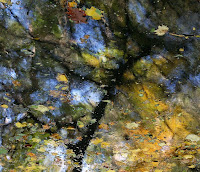
A while back, I posted an entry called
The Eightfold Way of the Artist, in which I describe the basic "steps" by which most artists - and most photographers (not that there is any meaningful difference between the two;-) - typically develop an aesthetic language over a lifetime's worth of "seeing" and "expressing" their own unique vision. That earlier discussion, however, was fairly abstract; and emphasized how the evolution of one's personal art may be used to reveal, over time, the artist "behind" the emergent work. I'd like to revisit this idea, but from a slightly more practical (but no less philosophically deep) point of view: namely, how the nature of the expressed art form itself changes over time, and what we - as artists - can learn from the forms of change.
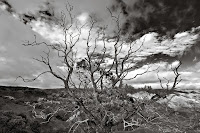
In keeping with this entry's more prosaic tone (though, as I glance ahead to what I wrote below, I'm not sure how much "philosophy" I've actually stripped from my earlier post; I'll leave that up to the patient reader to decide;-), I should note that it was prompted by a disarmingly simple and straightforward question my mom asked me a few weeks ago (well, it was straightforward, but only before I realized that
answering it - in a meaningful way - would prove anything but). Having just seen my
Micro Worlds portfolio, my mom asked:
"Andy, these are lovely, but why do you take so many pictures of the same thing? You used to show me such a variety of subjects; why the change?"

My immediate reply was accurate but shallow. I said that I no longer find individual images adequate to fully express what I want to communicate about what I'm seeing and feeling. My mom - who is not used to shallow answers about art, having lived with a rather deep artist (namely, my
dad) for as long as I can remember - called me on my flippant reply, and probed for something deeper. I tried again: "I don't think in terms of individual images anymore; and when I see a subject that interests me, I want to explore it more, with multiple exposures and viewpoints." In some ways, of course, that was worse than my first answer...my mom countered with:
"Andy, you've restated my question quite nicely. Now, how about explaining why you don't think in terms of individual images anymore?"
What follows is a summary of the deeper answer I gave my mom after I took a few hours to ponder her probing question. I concluded that my mom very perceptively discerned a genuine meta-pattern shift in the gestalt of my photography; and that the essence of that meta-pattern shift provides an important clue as to what stage I'm in, in my natural (and still very much ongoing) evolution as an artist. I also thought that it might be a worthwhile exercise to think through, and describe, the various stages that I suspect most (if not all) photographers gradually move through as they mature as artists. While my notes contain the germs of ideas for "stages of artistic evolution" whose numbers range from a only a few to more than a dozen, I eventually settled on eight stages (perhaps an unconscious homage to Buddha's
Eightfold Path).
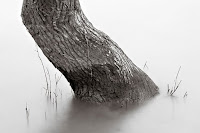
Let me begin by stating up front that my description of the "8-fold path toward self-discovery" in no way implies that I have any special insight into the deepest strata of art or photography; it is offered simply, and humbly, "as is" and is to be read - and understood - purely as an expression of but one point of view (which the reader is entirely free to disagree with; indeed, I hope does disagree, with at least parts of it, so as to foster a dialectic by which we can all collectively probe the meaning of art and photographer even deeper).
"A man's work is nothing but
this slow trek to discover,
through the detours of art, these two or three
great and simple images in whose
presence his heart first opened."
- ALBERT CAMUS
Stage 1: Joyful snapshots of anything and everything. What is the first thing anyone who gets a new" toy" (or serious tool) wants to do? Play with it, of course; see what it can do, learn how to use it - mechanically, at least - and just have some fun with it. The beginning photographer - such as I remember myself being when I was barely 10 and my parents had given me a Polaroid instamatic camera for Christmas - doesn't really care much about anything other than taking pictures of whatever strikes their fancy. And that's precisely what they get: pictures of their dog or cat, their room, mom and dad, their own reflection, snapshots of their friends, a tree, a shoe, a baseball game, an apple, whatever. Everyone begins somewhere; and that "somewhere" for photographers is a joyful - but otherwise essentially indiscriminant - expression of a new found tool that takes pictures. And pictures they will take; all kinds of pictures, with hardly any rhyme or reason. In a basic sense, anyone who is alive and is the least bit curious about the world - and is given a camera, or any other artistic tool - instantly becomes a stage-1 artist.
 Stage 2: A passive stirring of aesthetic value.
Stage 2: A passive stirring of aesthetic value. As the photographer evolves from stage one to stage two, she still takes images of anything and everything that strikes her fancy but now finds that
certain objects draw a deeper attention than others. Her gaze still falls on most everything that surrounds her, but her embryonic photographer's "eye" begins to discern that aesthetic value is not homogeneously distributed; certain scenes, and certain things, draw her eye more than others. For the first time, though perhaps weakly, some aspect of the environment draws the artist's attention. But the second stage artist is mostly passive, reacting to aesthetic stimuli as they appear and are recognized, but still largely undiscerning as to their relative merit and eager to "take in as much as possible." The stage-2 artist creates pictures in which others recognize that certain things are given more or less visual weight than others; but - because the stage-2 artist is still only a "beginner" - the pictures themselves are not necessarily as aesthetically pleasing as they could be.
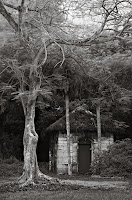 Stage 3: Willful engagement of the aesthetic environment.
Stage 3: Willful engagement of the aesthetic environment. The transition from stage two to stage three is both difficult to see "from the outside" (for observers of the artist's inner journey) and dramatic (as experienced directly by the artist). The transition occurs when the artist finds herself discontent with the merely passive capture of objects, and instead actively seeks objects she deems "interesting." She has started to categorize the world according to her own unique measure(s) of lesser and greater aesthetic value. Objects (or places, or people, or situations, ...) that the stage-three artist holds in high regard become beacons in the environment that both immediately draw the artist's attention, and are "attractors" toward which the artist actively makes her way. If the artist finds
trees of particular interest, for example, she is no longer content with leaving a park with a "few stray shots of trees," but now deliberately goes to different parks (and other places that has lots of trees) to "see" as many different tree as possible. The stage-three artist begins to learn what she values most, and then goes out to find it. She also learns to better express what she "sees" and is better able to create aesthetically pleasing images. "Objects" of attention in the stage-3 artist's picture repertoire are no longer appreciated by others merely as objects that clearly "stand out" from the background, but as bona-fide "aesthetic elements" assembled by the artist's growing creative powers of expression.
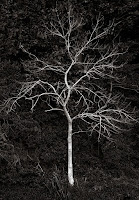 Stage 4: Recognition of the power of expression.
Stage 4: Recognition of the power of expression. The transition between stage three and stage four is marked by a gradual recognition of the power of using photography - traditionally, a print - to express not the object itself, but
what draws the artist's attention to the object. In practical terms, this means that the stage four artist is concerned less with depicting trees merely as objects of interest (in keeping with our "tree" example) - being quite happy to display a set of "shots of pretty trees" that are otherwise unremarkable in any way - and more with finding the one shot (and the one resulting print) that best expresses to others why the artist loves to photograph trees. This subtle (and not so easy) transition represents a very significant worldview shift; as well as a shift in artistic sensibility. Indeed, many artists (myself included) find themselves "stuck" at the boundary between stages 3 and 4 for years, as they patiently develop and explore ways to express meaning, and not just being. Making matters even more difficult is that the stage 3->4 transition involves a gradual recognition of - and increased attention to -
two different worlds of reality and expression: (1) attention to using a print to isolate the
tree as it "appears" to us, as an otherwise embedded feature of the external environment, and (2) attention to using post-capture tools (either in a traditional or digital "darkroom") to properly express the most "important" features of the
tree as captured in a photograph. Again, this distinction is both subtle and deep. It is meaningful only insofar as the stage-4 photographer realizes there is an important aesthetic difference between using tools to render differences between trees and their environment (in order to "make them stand out" better from the surrounding clutter), and using tools to selectively render the inner parts of a given photograph (the first inkling to dodge, burn, and make other tonal "changes" to an image), so that the viewer can better "see" what the photographer is trying to express. The slow and careful learning, nurturing, and refining of these skills can (and often does) take years, if not decades, to develop fully.
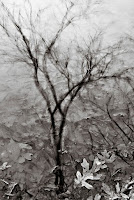 Stage 5: One picture is not enough.
Stage 5: One picture is not enough. Sooner or later, but only after comfortably settling into stage 4, every artist yearns to go beyond the "image" - to go beyond just showing a single picture, or at most a few individual prints, of a subject the artist holds dear. More effort and more care are put into every single capture (and its attendant post-capture processing); and more and more finished prints are deemed "worthy to show others" by the artist. But the stage-5 artist also grows increasingly dissatisfied over what she is beginning to perceive as "too shallow" an expression of an inner vision that is slowly trying to make its own voice heard. "I like this tree," she finds herself thinking to herself more and more often, "but it doesn't -
can't ! - by itself express
why I've been taking pictures of trees for as long as I have." She continues, "Each of my trees is lovely, and I'm proud to show them to others, but I'm somehow missing the bigger picture here. It is as though each of my pictures is a chapter in a book yet to be assembled." The artist may not yet quite know what this nascent "book" is, what form it will eventually take, or what it will "say," but her aesthetic eye has measurably raised its line-of-sight to higher levels. The stage-5 artist no longer thinks (or "sees") in terms of individual pictures. Rather, the world is seen as a
patchwork; a tapestry of overlapping images. Or, simply, in terms of
groups - or portfolios - of pictures.
 Stage 6: Telling a story.
Stage 6: Telling a story. Inevitably, the artist becomes interested in not just putting together a set of assorted - but only marginally related - prints (as in collections of "best of" shots), but in carefully crafting and sequencing the images in a portfolio of prints to
tell a specific story. If the original interest was (and remains)
trees, for example, the artist now wishes to move beyond her ever growing collection of "individual trees," to a new form of expression designed to reveal both how "sets of trees" are related, and a bit of the process by which the artist's perception and expression of her general "love of trees" has itself evolved over time. The stage-6 artist thus naturally steps away from a focus on prints
as prints (even if they are otherwise a part of a larger collection) and moves toward an increased focus on
portfolios of interrelated images. It is no longer enough to just find that one "good" or "best" image - even if it is one for the ages (though any artist is always happy to find it! ;-) - the artist now first thinks in terms of mutually related groups of images. Ideally, each image both stands on its own and compliments and/or enhances all of the others. In more practical terms, the artist now wishes to express not so much her love of "trees"
per se, as represented in the "best possible way" by a single image, but a deeper aesthetic experience of trees in general; as exemplified perhaps by a selection of personally meaningful images captured in a favorite park, or accrued over several weeks or months (or years) even as the artist explores other subjects and themes. The stage-6 artist's attention has moved from "pictures" to
projects that culminate in portfolios of interrelated images; all motivated by a growing desire to use sets of images to tell a story about what the artist's eye (and heart) is drawn to, and
why..
 Stage 7: Portfolios of Portfolios.
Stage 7: Portfolios of Portfolios. The penultimate stage typically appears only when an artist has attained a certain level of "aesthetic maturity"; by which time a meaningful body of work - consisting mostly of portfolios (though "individually meaningful" images still pop up from time to time) - has naturally emerged. Each and every portfolio has both a story to tell, and is an element of an as-yet unrevealed and unrealized deeper story; a story about which the stage-7 artist hears the first faint murmurs of. A story concerning the truths of the world "out there" as revealed to the photographer through her lifetime's worth of aesthetic judgements as to what to shoot, what to keep, how to express, what to show, and what to sequence into portfolios. The artist realizes that her art has not only captured an aesthetic
impression of the world - an aesthetic that is uniquely hers, though the details may overlap with that of other artists - but is a manifest imprint of a deeper
aesthetic order of the external world. The artist begins to understand and appreciate certain universal objective truths by examining the subjective aesthetic order that she herself has "imposed" on the world. By studying her own
portfolio of portfolios - as though her life's work was itself a "world" open to capture with an aesthetic eye and camera - the artist discovers universal truths about the world itself. In my own case (though I suspect I am far from moving into stage-5, much less stage-7), I can glimpse some of the feelings associated with a stage-7 worldview by looking inward to my motivation for creating my recent "portoflio of portfolios" called
Sudden Stillness.
Sudden Stillness consists of four fundamentally interwoven portfolios called
Chaos, Order, Complexity, and
Entropy. The subtitle of the book conveys the deeper meaning behind (and reason for the particular sequencing of images in) the book:
visual echoes of timeless rhythms. Collectively, the four portfolios weave a "story" about the fundamental rhythmic patterns that regulate our world (from this one photographer's point of view, of course). In short, the stage-7 artist uses her own work - consisting now mostly of portfolios of portfolios - to transcend art and begin addressing deeper and universal themes and issues regarding the order of the world around her. Art is no longer concerned solely with the here and now - for its own sake, and regarding limited sets of objects, themes, and contexts - but assumes an added dimension of seeking a transcendent truth about the nature of the world itself. And part of that truth is revealed - to the artist - by the artists own body of work.
 Stage 8: Self-discovery.
Stage 8: Self-discovery. Stage-8 is not all that different from stage-7, at least outwardly, and if measured objectively in terms of the artist's physical output (in terms of images and prints). The stage-8 artist still typically produces
portfolios of portfolios, still diligently practices her artform, relentlessly striving toward perfection, and delights with each every "beautiful print" as though it was her first, just as she has always done and will always do; but the artist shows no outward sign of doing anything different from the stage-7 artist. Indeed, paradoxically, the stage-8 artist may even appear
to others as being stuck on a plateau (albeit an aesthetically very high one), and no longer willing, or able, to "evolve" artistically. But something fundamental has changed - and in a dramatic way, but one invisible to anyone but the artist at first - in the way the artist understands and interprets her own work. Of course, all of the technical components of image capture and mechanical procedures of post-capture processing have long ago been turned into virtually reflex action on the artist's part. Without this being true - something that requires years and years of dedicated and full immersion in art - no artist can progress to stage-8 (this - namely, the need for
total immersion - also appears to be universally true of any creative field, if the practitioner wishes to attain the highest levels of "creative accomplishment"). And what is the fundamental change that occurs? In the same way as we indicated that the stage-7 artist uses her art to uncover truths about the world, the stage-8 artist discovers
truths about her own soul. The world, and the artist's own work, have both come full circle: the world revealed through an artist's vision; and the artist's expression of the world uncovering the depths of the artist herself. Seer and seen become one; and the seen brings the seer back to self.
“A man sets out to draw the world.
As the years go by, he peoples a space
with images of provinces,
kingdoms, mountains, bays, ships,
islands, fishes, rooms, instruments,
stars, horses, and individuals.
A short time before he dies,
he discovers that the patient labyrinth
of lines traces the lineaments
of his own face.”
- JORGE LUIS BORGES
 Regular readers of my blog, and those that have seen my work in Lenswork , Focus, and Black & White magazine, know that I am primarily (indeed, almost exclusively!) a black and white photographer. While I have dabbled with color in the past, and print in color on occasion (the last time involving images taken in Hawaii, with an "explanation" provided by this 2006 blog entry), almost everything I do "seriously" (and seriously try to sell) is in black and white. O'Reilly publishing also published a "color portfolio" (of sorts) of some flowers, but these were considerably older than the "2005" byline date would suggest, and - moreover - were never meant to be part of a larger body of work. Generally speaking, and without apology, color is simply "not my thing."
Regular readers of my blog, and those that have seen my work in Lenswork , Focus, and Black & White magazine, know that I am primarily (indeed, almost exclusively!) a black and white photographer. While I have dabbled with color in the past, and print in color on occasion (the last time involving images taken in Hawaii, with an "explanation" provided by this 2006 blog entry), almost everything I do "seriously" (and seriously try to sell) is in black and white. O'Reilly publishing also published a "color portfolio" (of sorts) of some flowers, but these were considerably older than the "2005" byline date would suggest, and - moreover - were never meant to be part of a larger body of work. Generally speaking, and without apology, color is simply "not my thing."








































